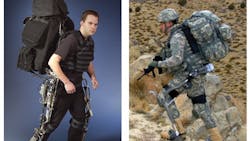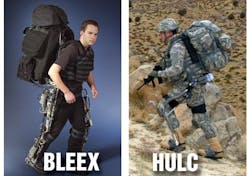Uncanny Exosuit: The Industrial Exoskeleton Made for Real Work, Not Movies
Even the toughest, strongest warehouse worker is at risk to missing several months due to a back injury, or could someday lose his job entirely to a robot that can work 24/7. After all, muscle fatigues; metal doesn’t.
That’s why industrial exoskeletons may be the most important innovation for the working class in the 21st century.
And creating ability-enhancing exoskeletons is Prof. Homayoon Kazerooni’s life’s work. You could call the director of the Berkeley Robotics and Human Engineering Laboratory the father of industrial exoskeletons, though he prefers “Kaz.”
That’s because making things easier is what this roboticist is all about, from lightening soldiers’ loads (by up to 75 lb.) with the DARPA-funded Berkeley Lower Extremity Exoskeleton (BLEEX) in 2000 to the recently launched Modular Agile eXoskeleton (MAX), an affordable, austere complement of three bionic pieces (legX, backX, and shoulderX) that individually reduce strain and tension at the knees, back and shoulders, where 90% of workplace injuries occur. It’s manufactured in the U.S. by suitX, the latest company created by Kazerooni.
Last December, on the day suitX was preparing to ship the very first MAX systems (price for all three modules: $11,000) to a Hong Kong construction company, we caught up with Kaz to talk about how the MAX was developed:
NED: We know exoskeletons are supposed to do; what does the MAX specifically do?
Kaz: Based on experiments done in lab, we are dropping stresses by about 50% for payloads of 30 or 40 lb. As the payloads go up to 100 lb, they reduce about 40%. If you’re picking up 50 lb, it makes it feel like 20 to 25 lb.
The whole idea was to make this a modular device because not every worker’s job is the same. One reduces one knee, one back, and one in the shoulder, and you can wear them together.
We were looking for something accessible. It’s like making a Honda vs. making a Lamborghini. Making a Lamborghini is not that difficult to me. You just keep adding things on. Creating a smaller car that millions of people can drive and is still useful—that’s a huge deal. Unless you want to turn at a track at a 100 mph, the Honda is just fine. The performance is identical when you go 35 mph. That’s what I was looking for. That’s what MAX is all about.
It’s the best thing I’ve been involved in in my entire life, mostly because the promise of getting it accessible to people is a huge deal to me.
NED: What do you mean by accessible?
Kaz: There’s a huge difference between products and technologies. Many technologies cannot be products. They’re just cool tech, great for program directors, great for researchers, great for entertainment. And we were looking to make an exoskeleton that’s real, that’s not science fiction, not just a laboratory experiment. For this is be a product, everything had to be simple, functional at lowest possible cost. If you make a building, to make it cost effective, you can’t afford to buy a $20,000 exoskeleton. That’s the business. A contractor who has 20 workers just wants his workers to come back the next day. They don’t want to spend too much money.
NED: How does it work?
Kaz: We used passive torque generators, springs, compressed gas springs, all kinds of devices that resist motion and get them to engage and disengage really cleverly. That’s the patent-pending portion. The hard components are made of plastic, aluminum, steel, bronze and the soft that come into contact with the user are the same material you’d find on a backpack. We put it all together with simple mechanisms that can be replaced easily in the field. In total, there are six actuators we made all ourselves. A microprocessor controls the device in the left and right leg. It’s very cheap and very small. It has Bluetooth that can tell if I’m going up stairs or downstairs, or squatting. You can go up ladder, down ladder, climb forklifts. One of my students does yoga, and I asked him to do all the yoga motion wearing device. He was able to do most of it. You will never be impeded by any motion, maybe 2-5% of really weird motions.
NED: It sounds like it makes the worker a giant torque wrench. Who is it for?
Construction, first responders, nurses, these people put their bodies in abuse and work very hard every single day. What we want the MAX suit to do is maintain that job for them, but augment them so they have a better quality of life, a better quality of work environment without having the fear of injuring their knees because they’re squatting for a long time, having back injuries because they’re bending all the time. The Department of Labor 2013 stats say most injuries come at the back, shoulders and knees. Many of these are not because people are picking up anything heavy. The average tool holder is 20 lb. People get hurt not because of heavy objects, but because of the repetitiveness.
New Equipment Digest is an IndustryWeek companion site within Penton's Manufacturing & Supply Chain Group.


